How to use people to improve your photography
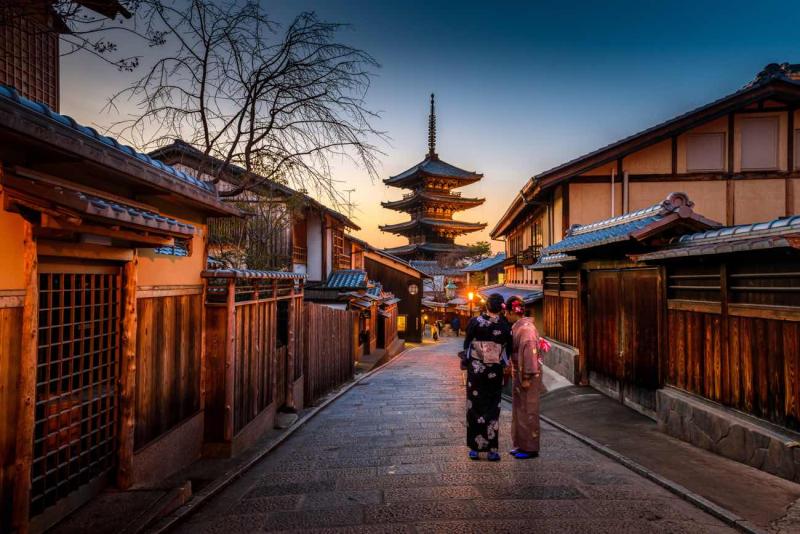
People are literally everywhere. At least that's how it feels when you live in a densely populated city like Portici. For a long time, I was very picky about whether I could have people in my shot.
I painstakingly removed people in post-production with the clone tool or by merging multiple exposures. Sometimes, I didn't even take my camera out of my bag, because I believed there was no possibility of a shot to be taken due to the presence of other human beings. I spent most of my time looking at the work of professional landscape photographers shooting in remote parts of the world, so I had developed the idea that photos looked better without people in the frame. Over time, I realized that not only was I being too stubborn, but I was wrong and that was holding back my photography.
While it's true that some places work well enough on their own, sometimes adding people can improve an image. In this article, I 'd like to share with you some of the ways I not only learned to use people in my shots, but also started waiting for them and adding them to enhance the scenes I was photographing.
I anticipate that none of the images I have chosen in this article has been built. I know many photographers use models, friends or themselves within the frame of their landscape or cityscape photos. Let's be clear, it's an absolutely valid way to use people in your images, but for the examples in this article I've only selected photos that were taken organically, so I didn't include any posed or constructed photos. I'm also not going to get into pure street photography , as including people in that style is more or less the rule. While some of these photos use elements of street photography, I wouldn't consider them street photography.
Add scale to the scene
In a perfect world, we would always have a banana with us to use as a ladder. However, in the absence of the potassium-rich fruit, there's no better way, or nearly so, to add a sense of scale to your images than with the inclusion of a person. In the past, as I said, the mere presence of one person would have turned me away from a number of locations, but in recent years I have often found myself hoping that someone was in the place where I intended to shoot with the intent to use it in my photo for scale. When using people for scale, it's important to consider things like focal length; the distance from the camera and the subject; and placement within the frame.
Here are some photos taken in extraordinary places, which simply wouldn't work as well without the people.
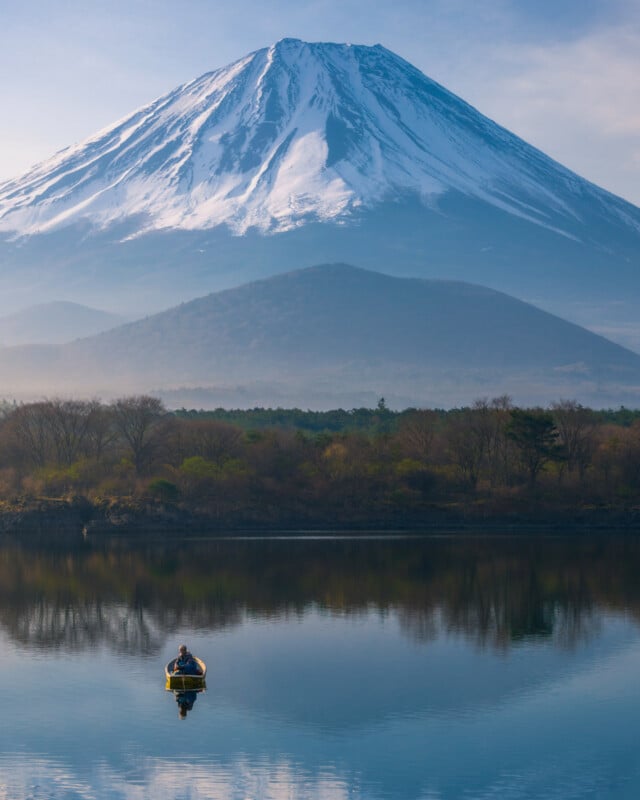
This image of Lake Shoji is a classic example of how one person can add a sense of scale to an already iconic landmark. While the location is stunning, the inclusion of a person transforms it from what appears to be a morning snapshot into a perfectly timed photograph. Ensuring the boat was positioned between the reflection of the trees and the snow covered area of Fuji was key to the balance of this image.
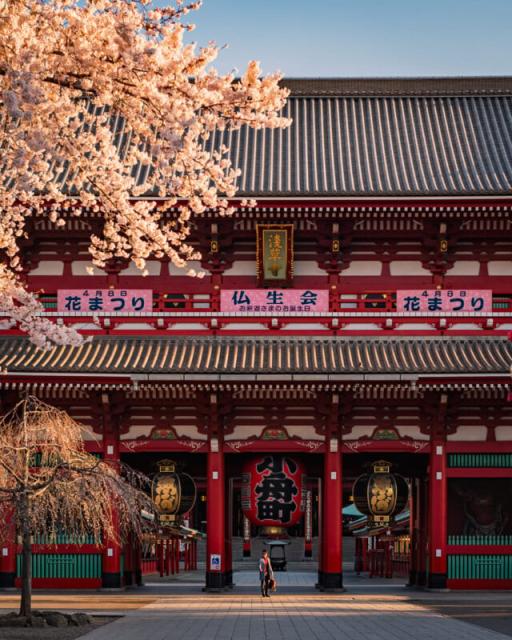
Scale is not limited to natural landmarks; it can also be used for artificial ones. This morning image from Senso-ji in Tokyo uses a person to not only show the gate's stairway, but also the lantern that hangs at its center. The photographer certainly had some luck with the light in the right spot, but patience in photography is sometimes rewarded with photographs like this.
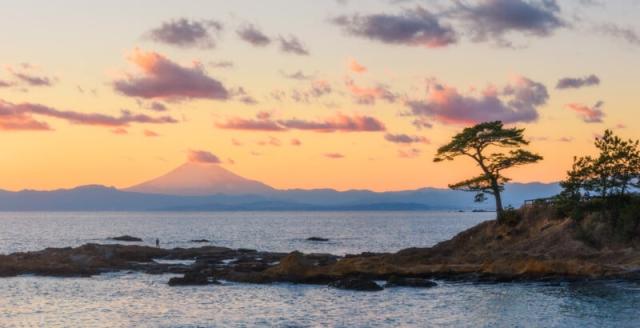
While the light and landscape in this Kanagawa image work well on their own, the subtle addition of the fisherman adds an extra sense of scale to the image that brings it all together. If I had taken this image a few years ago, I would have removed the fisherman on the left and the people on the right, but now I understand that they add value to an already picturesque location.
Introduce life onto the scene
Sometimes a scene or place works by itself. The light and elements within the scene combine to create a stunning image that needs no additional elements. However, other times we may look at a scene or photograph and think that something is missing or that the photo could use something more. In these cases, I have often found that something extra is the presence of life within the scene. As I said before, I was once adamant that my landscapes contain no people. However, in the last few years, as I've started to appreciate the presence of people, I've taken a lot of photos that wouldn't have worked without that feeling of life that people in the frame add. I've found that using people to add a dash of life works best in urban areas or villages; after all, we don't live in a post-apocalypse world.
As with scale, the tricky part of using people to add life to the shot is ensuring that the people within the shot enhance the elements around them with ideal placement within the scene. It all boils down to the person integrating into the scene organically without jarring like a sore thumb. This is why I prefer to use people organically, rather than choosing to pose them within the scene.
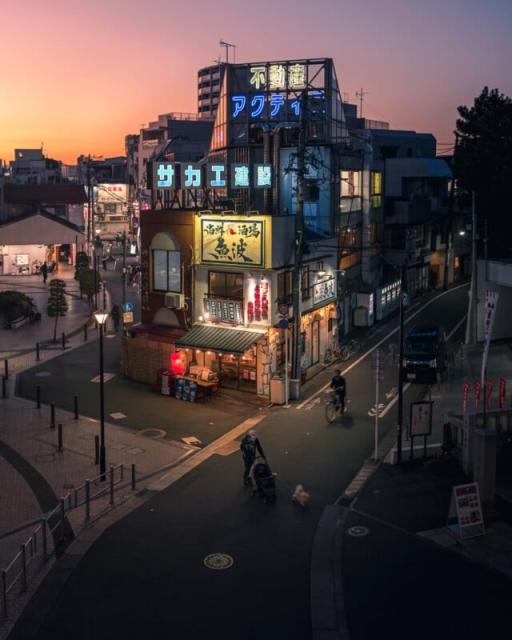
This is probably the most photographed izakaya on the planet. I've seen it photographed countless times by well-known and lesser-known photographers from around the world. However, the photos of this place that stand out to me the most are the ones that have added the extra element of life within the frame in an organic way. I won't declare this photograph as the best photo ever taken from this location, but I definitely wouldn't have chosen it without people within the frame adding life to the scene.
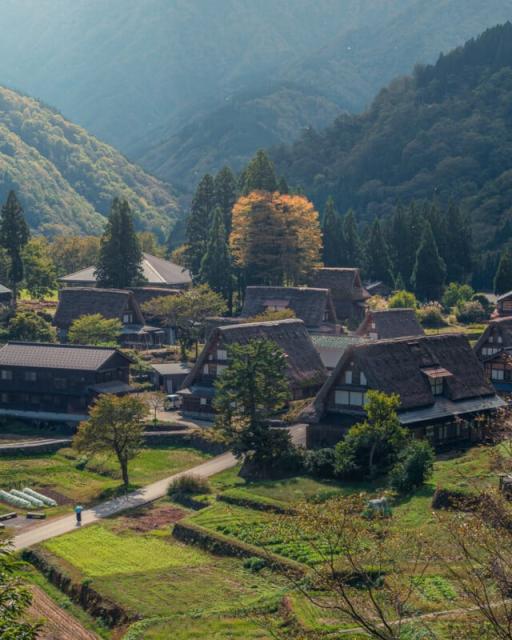
From an iconic spot in the bustling streets of Tokyo to a lesser-known one nestled in the mountains of Toyama Prefecture, the technique remains the same. I believe that the photographer knew that he would need a person to enhance an already splendid location. The photo was taken in the middle of the day, as the shadows suggest, but the inclusion of the woman in the lower left plays a big part in this image.
A photographer like me a few years ago probably would have left this place without a photo, as the harsh light really leaves a lot to be desired. Luckily, the photographer who took this photo sat there a long time for the right person to get into the frame, and it was worth it. In addition to adding life to the frame, the person serves as a sense of scale for both the village and the mountains that surround it. So if you find a location, but feel it needs something more, it's worth waiting for the right time to develop.
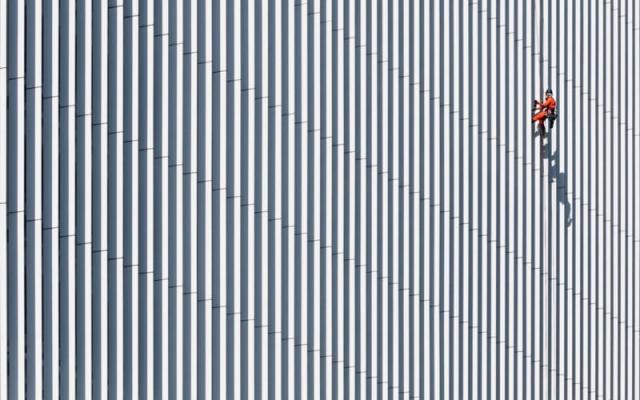
The use of people goes beyond photography of vast scenes or cityscapes, it can be applied to more intimate settings as well. This is an example of an image that just doesn't work without the inclusion of life within the frame. While the angle of this building in this image of abstract architecture is whimsical in itself, it's not enough to create a strong image. In addition to a pop of color, the window cleaner offers the viewer a clear focal point in an otherwise too simple image.
Transmit movement within the scene
While photography is an art medium that focuses on still images, that doesn't mean your image needs to be devoid of motion. In an interview regarding her installation art entitled "Work No. 850", Martain Creed said: "If you think of death as being completely still and movement as a sign of life, then the fastest possible movement is the greatest sign of life". in this spirit, one of the best ways to use people in photographs is to shoot them with a long exposure to add a sense of movement within the image. While this can be tricky as it can require extra equipment like a tripod and ND filters as well as having to choose the ideal shutter speed, the movement created can add an extra layer of interest that takes a photo to the next level. Also, this is a great way to practice shooting on purpose, in preparation.
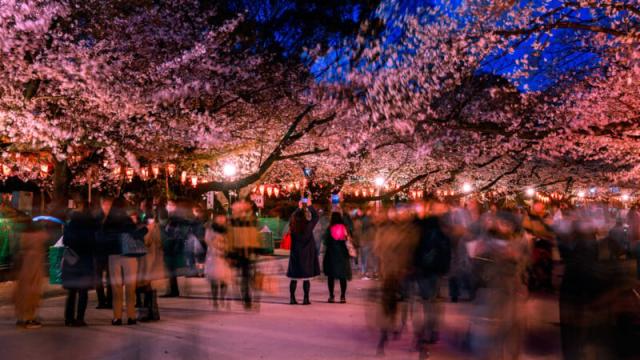
In this photo, the photographer managed to frame the two women in the center of the image and just in time to take this single shot. The chaos in the movement around them adds to the mood of the image, while they stand alone as a subject. If this photo had been taken with a faster shutter speed, the women would have been lost in the sea of people. Had it been taken with a longer exposure, they would have moved around, eliminating themselves as the subject. Accuracy is key when trying to take a single image that blends stillness and movement, but when done right it can enhance what would otherwise be a snapshot into something much stronger.
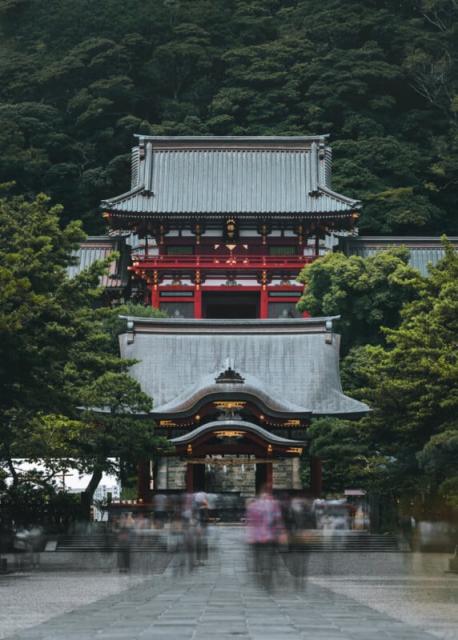
Another single image, taken in Kamakura, the exposure of this photo leaves people walking around this iconic shrine like ghosts. With techniques like this it is possible to take interesting photographs, even in the middle of the day, in one of the busiest tourist attractions in the prefecture. Of course, timing is important here too. If too many people cross the frame, you'll end up with an indistinguishable jumble of colors. If you expose the image too long, you will lose people altogether. Weather conditions and the number of people passing through the frame change the specifics of these settings, so be sure to take a few test shots before waiting for the perfect moment to snap.
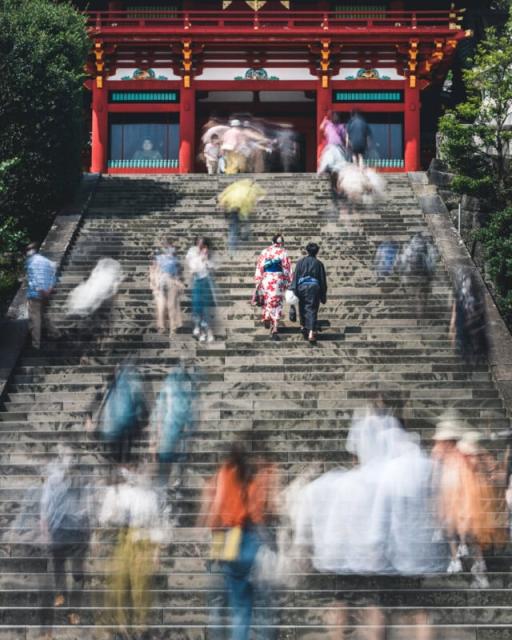
I mentioned earlier the importance of study and preparation, even more if we refer to the use of more advanced editing techniques . This photo is an example of a shot designed to use people in the frame. While this photo may seem fabricated at first glance, it's entirely spontaneous—believe it or not, the photographer didn't ask people to stand completely still on those steps for an extended period of time. Most likely, he first took a photo of the people in modern clothing walking up and down the stairs with a long exposure, and then took a single photo of this couple in traditional Japanese clothing to create an artistic image using movement to separate the past from the present.
Tell a story
I thought storytelling was reserved for street photography, not landscape or architecture photography. However, I now understand that they don't have to be mutually exclusive. As Fan Ho has shown through her work , it is possible to capture a larger scene by using the people within the environment to tell a story.
Whether or not the following images are street photography is a discussion perhaps best left unsaid, the fact remains that the inclusion of a person in each of these images adds a story that enhances them. This technique is a great way to enhance an image when you don't have perfect conditions or want to create a unique image in a popular area. The challenge with storytelling is that you don't have control over how people behave in public, but you want to photograph them doing something that appears to convey a story. These types of images become easier to capture the more familiar you are with a place or culture. None of the following images were taken by accident. Rather, they are a direct product of understanding Japanese culture, how people tend to behave in these places or situations, and an immense amount of patience.
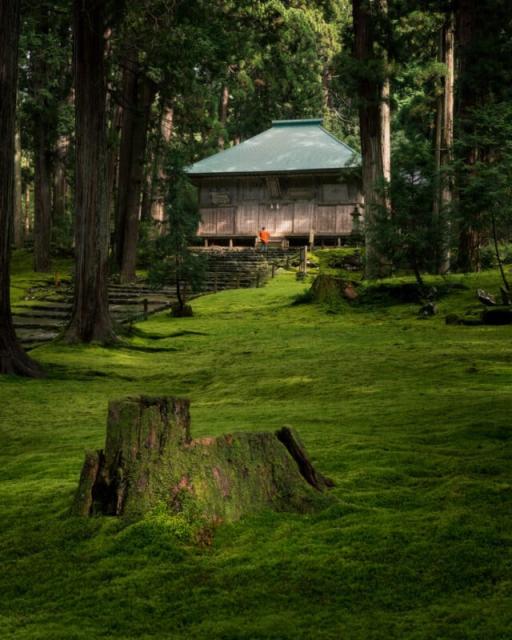
While this location is pretty cool in its own right, the flat light and sheer amount of green within the scene leaves a lot to be desired. The addition of the man taking a moment to pay his respects at the shrine adds a simple but essential story to this image that so many other shots taken from the exact same location lack. Its presence also adds that touch of life I mentioned earlier, as well as a sense of scale and a touch of color contrast.
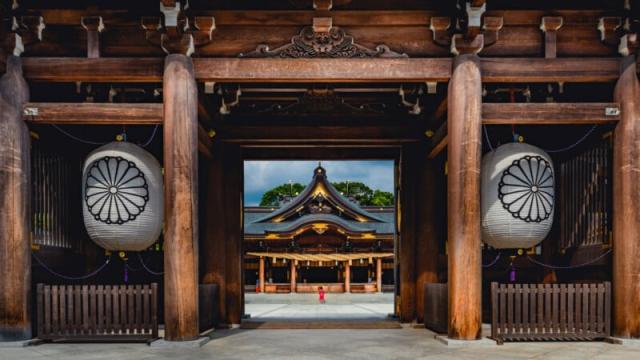
Staying with the theme of using shrines to tell a story, this is a shot that combines architectural photography with a touch of storytelling. While the fine detail and near-perfect symmetry that traditional Japanese architecture offers is worthy of photographing on its own, having the woman in the red dress not only adds scale and life to the photo, it tells a simple yet effective story across the culture. . I often hear people talk about how they don't live in an interesting area, but the inclusion of a story can transform any location, however unknown or otherwise anonymous, into a unique photo opportunity.
Show the culture
Sometimes, simply capturing a location isn't enough. Whether it's a traditional area or a landscape, adding people within the frame can also be used to capture the essence of the place, local culture or event. While many of these places and scenes work well enough on their own, the inclusion of the people helps capture the culture inherent within them. I should have used the word culture in the storytelling section because they often go hand in hand, however, culture deserves its own section because it can vary from place to place. That's why when adding touches of culture to your image it's imperative to understand the regional traditions and cultures that define it.
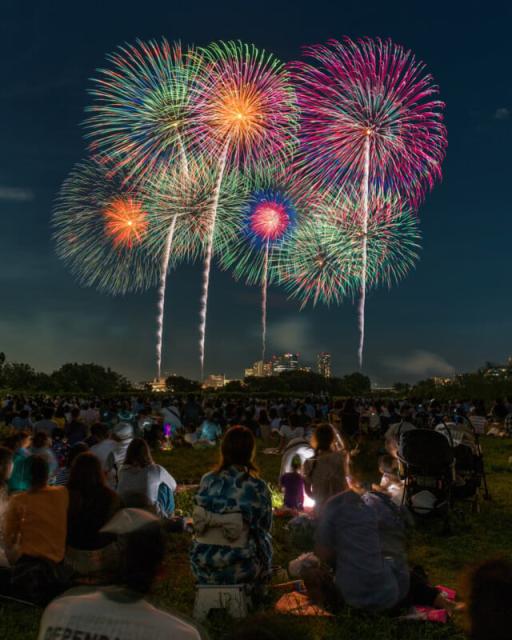
There are some photographers who scoff at fireworks photography, but if you shoot them right, they can be a powerful subject. One mistake I often see photographers make is to only photograph fireworks. However, when people are added to the foreground, they can enhance the scene by adding a dash of energy and culture to the image. This particular image is a mix of exposure, using the girl in kimono to show the fireworks culture in Japan. As summer approaches, I recommend that you try this technique at local firework festivals. Arrive earlier than usual and try to find interesting compositions, just like you would when shooting a landscape and take some test shots. If you're worried that the scene might change or become too dark, you can shoot the close-up early and fade out the fireworks later.
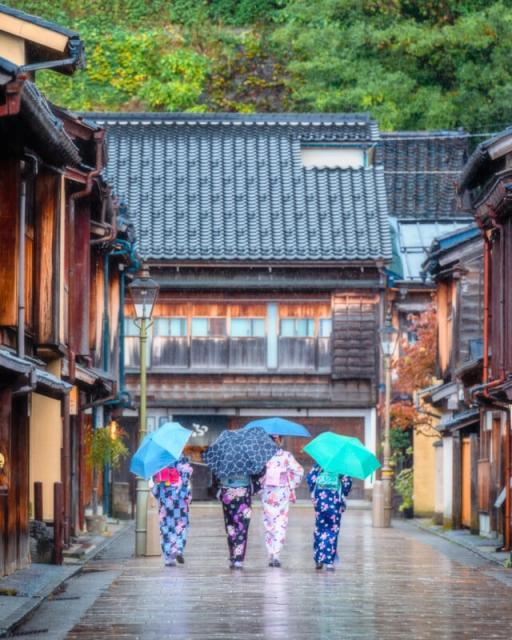
The Higashi-Chaya area of Kanazawa is a breathtaking place that can stand on its own. However, the photographer on a very rainy morning, fortunately, did not miss the opportunity to photograph this traditional part of the city with these girls in kimonos. Sure, the inclusion of the girls doesn't really tell a story, but it does help showcase the rich traditional culture of this area of the city, while also adding life and a pop of color. I've seen other photos taken in this location, but none show the essence like this one, thanks to these girls... and, well yes, also thanks to the rain.
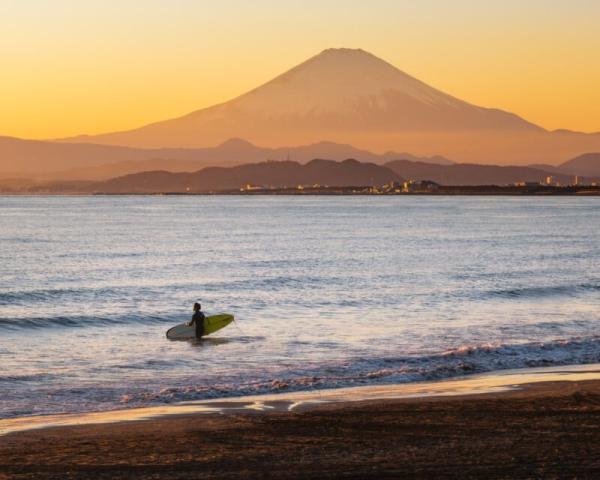
The Shonan area in Japan is like no other. While the location is less well-known to most tourists, it's the only place in the entire country to get a view of Mt. Fuji with surfers, at least as far as I know. While a photo of Mount Fuji would normally stand on its own, the addition of the surfer in this image adds a touch of local culture that makes it unmistakably Shonan. When you include people within the image, it's not only an opportunity to showcase the scenery, but it also allows you to introduce a unique aspect of the culture to the area with people from all over the world.
Conclusions
Photography is a powerful tool. It can be used to tell stories, document history, capture personal memories or make art. These things don't have to be mutually exclusive. For photographers starting out and focusing on landscapes and urban scenes, I encourage them to try including more people in their photography. Not to think of the people in their shot as a nuisance, but to try to use them to improve their work, using the techniques I've highlighted in this article. I'm sure spending more time with the camera in my hands, practicing. They will be able to start appreciating even those places that they have dismissed as boring, they will start to see them in a new way. Ultimately, it is this power to help us see the world in a new way that makes photography so special.
When you subscribe to the blog, we will send you an e-mail when there are new updates on the site so you wouldn't miss them.
By accepting you will be accessing a service provided by a third-party external to https://www.insightadv.it/


































































Comments